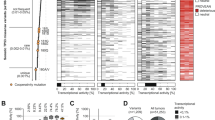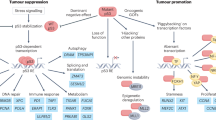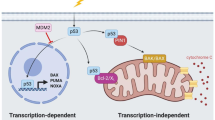Abstract
The p53 pathway is inactivated in most human cancers, and its reactivation in tumors appears as a promising therapeutic strategy. Overexpression of Mdm4, a p53 negative regulator, occurs in a significant fraction of human cancers. Mouse models were used to evaluate the therapeutic potential of strategies against Mdm4, and encouraging results were obtained for tumor cells in which Mdm4 overexpression prevents wild-type p53 to exert its tumor suppressive functions. However, missense mutations in the p53 gene occur in about half of human cancers, and 15% of such mutations lead to the expression of a mutant protein that retains partial activity. In this report, we used mouse models to address the therapeutic potential of strategies against Mdm4 in tumors expressing an hypomorphic p53 mutant. We found that, in an Rb+/− background promoting pituitary and thyroid tumors, decreased Mdm4 levels improved the survival of mice expressing wild-type p53, but not that of mice expressing p53ΔP, a p53 hypomorph lacking the proline-rich domain. Importantly, however, most Rb+/− p53ΔP/ΔP mice developped pituitary adenomas, but these tumors were rare in Rb+/− p53ΔP/ΔP Mdm4−/− animals, because Mdm4 loss led to increased p21 levels, a suppressor of pituitary tumor growth. On the contrary, Rb+/− p53ΔP/ΔP and Rb+/− p53ΔP/ΔP Mdm4−/− mice developped anaplastic thyroid carcinomas at equal frequencies. Importantly, wild-type p53 represses the Plk1 gene, which encodes a promising therapeutic target in anaplastic thyroid carcinomas, and this repression is improved when Mdm4 levels are decreased. On the opposite, p53ΔP is a mediocre transcriptional repressor that is not improved by Mdm4 loss. In sum, depending on the tumor type, strategies against Mdm4 that work in cells expressing wild-type p53 may not work in cells expressing an hypomorphic p53. Furthermore, p53-mediated transcriptional repression should be considered when evaluating strategies to reactivate p53 in tumors.
This is a preview of subscription content, access via your institution
Access options
Subscribe to this journal
Receive 50 print issues and online access
$259.00 per year
only $5.18 per issue
Buy this article
- Purchase on Springer Link
- Instant access to full article PDF
Prices may be subject to local taxes which are calculated during checkout




Similar content being viewed by others
References
Toledo F, Wahl GM . Regulating the p53 pathway: in vitro hypotheses, in vivo veritas. Nat Rev Cancer 2006; 6: 909–923.
Marine JC . MDM2 and MDMX in cancer and development. Curr Top Dev Biol 2011; 94: 45–75.
Toledo F, Krummel KA, Lee CJ, Liu CW, Rodewald LW, Tang M et al. A mouse p53 mutant lacking the proline rich domain rescues Mdm4 deficiency and provides insight into the Mdm2-Mdm4-p53 regulatory network. Cancer Cell 2006; 9: 273–285.
Laurie NA, Donovan SL, Shih CS, Zhang J, Mills N, Fuller C et al. Inactivation of the p53 pathway in retinoblastoma. Nature 2006; 444: 61–66.
Bernal F, Wade M, Godes M, Davis TN, Whitehead DG, Kung AL et al. A stapled p53 helix overcomes HDMX-mediated suppression of p53. Cancer Cell 2010; 18: 411–422.
Vaseva AV, Yallowitz AR, Marchenko ND, Xu S, Moll UM . Blockade of Hsp90 by 17AAG antagonizes MDMX and synergizes with nutlin to induce p53-mediated apoptosis in solid tumors. Cell Death Dis 2011; 2: e156.
Garcia D, Warr MR, Martins CP, Brown Swigart L, Passegué E, Evan GI . Validation of MdmX as a therapeutic target for reactivating p53 in tumors. Genes Dev 2011; 25: 1746–1757.
Gembarska A, Luciani F, Fedele C, Russell EA, Dewaele M, Villar S et al. MDM4 is a key therapeutic target in cutaneous melanoma. Nat Med 2012; 18: 1239–1247.
Petitjean A, Mathe E, Kato S, Ishioka C, Tavtigian SV, Hainaut P et al. Impact of mutant p53 functional properties on TP53 mutation patterns and tumor phenotype: lessons from recent developments in the IARC TP53 database. Hum Mutat 2007; 28: 622–629.
Leroy B, Fournier JL, Ishioka C, Monti P, Inga A, Fronza G et al. The TP53 website: an integrative resource centre for the TP53 mutation database and TP53 mutant analysis. Nucleic Acids Res 2012; 41: D962–D969.
Williams BO, Remington L, Albert DM, Mukai S, Bronson RT, Jacks T . Cooperative tumorigenic effects of germline mutations in Rb and p53. Nat Genet 1994; 7: 480–484.
Chesnokova V, Zonis S, Kovacs K, Ben-Shlomo A, Wawrowsky K, Bannykh S et al. p21(Cip1) restrains pituitary tumor growth. Proc Natl Acad Sci USA 2008; 105: 17498–17503.
Deng C, Zhang P, Harper JW, Elledge SJ, Leder P . Mice lacking p21CIP1/WAF1 undergo normal development, but are defective in G1 checkpoint control. Cell 1995; 82: 675–684.
Salvatore G, Nappi TC, Salerno P, Jiang Y, Garbi C, Ugolini C et al. A cell proliferation and chromosomal instability signature in anaplastic thyroid carcinoma. Cancer Res 2007; 67: 10158–10158.
Nappi TC, Salerno P, Zitzelsberger H, Carlomagno F, Salvatore G, Santoro M . Identification of polo-like kinase 1 as a potential therapeutic target in anaplastic thyroid carcinoma. Cancer Res 2009; 69: 1916–1923.
McKenzie L, King S, Marcar L, Nicol S, Dias SS, Schumm K et al. p53-dependent repression of polo-like kinase-1 (PLK1). Cell Cycle 2010; 9: 4200–4212.
Vassilev LT, Vu BT, Graves B, Carvajal D, Podlaski F, Filipovic Z et al. In vivo activation of the p53 pathway by small-molecule antagonists of MDM2. Science 2004; 303: 844–848.
Murphy M, Ahn J, Walker KK, Hoffman WH, Evans RM, Levine AJ et al. Transcriptional repression by wild-type p53 utilizes histone deacetylases, mediated by interaction with mSin3a. Genes Dev 1999; 13: 2490–2501.
Zilfou JT, Hoffman WH, Sank M, George DL, Murphy M . The corepressor mSin3a interacts with the proline-rich domain of p53 and protects p53 from proteasome-mediated degradation. Mol Cell Biol 2001; 21: 3974–3985.
Lohr K, Moritz C, Contente A, Dobbelstein M . p21/CDKN1A mediates negative regulation of transcription by p53. J Biol Chem 2003; 278: 32507–32516.
Jacks T, Fazeli A, Schmitt EM, Bronson RT, Goodell MA, Weinberg RA et al. Effects of an Rb mutation in the mouse. Nature 1992; 359: 295–300.
Jacks T, Remington L, Williams BO, Schmitt EM, Halachmi S, Bronson RT et al. Tumor spectrum analysis in p53-mutant mice. Curr Biol 1994; 4: 1–7.
Prophet E, Mills B, Arrington J, Sobin L . Afip—Laboratory methods in histotechnology. American Registry of Pathology, Washington DC, USA, 1992.
Simeonova I, Lejour V, Bardot B, Bouarich-Bourimi R, Morin A, Fang M et al. Fuzzy tandem repeats containing p53 response elements may define species-specific p53 target genes. PLoS Genet 2012; 8: e1002731.
Migliorini D, Lazzerini Denchi E, Danovi D, Jochemsen A, Capillo M, Gobbi A et al. Mdm4 (Mdmx) regulates p53-induced growth arrest and neuronal cell death during early embryonic mouse development. Mol Cell Biol 2002; 22: 5527–5538.
Acknowledgements
We thank members of the Curie technological platforms for their contribution to this study: I Grandjean, C Daviaud and M Garcia from the Animal facility and M Richardson, M Huerre and A Nicolas from the Pathology service. We also thank L Plancke and L Charbonnier for their help with mouse dissections, and GM Wahl and M Debatisse for their support. Funding was provided from the Fondation de France (Comité Tumeurs), the Association pour la Recherche sur le Cancer, the Ligue Nationale contre le Cancer (Comité Ile de France) and the Institut National du Cancer. MF and IS received predoctoral fellowships from the Cancéropôle Ile de France, the Ministère de l’Enseignement Supérieur et de la Recherche and the Ligue Nationale Contre le Cancer.
Author information
Authors and Affiliations
Corresponding author
Ethics declarations
Competing interests
The authors declare no conflict of interest.
Additional information
Supplementary Information accompanies this paper on the Oncogene website
Supplementary information
Rights and permissions
About this article
Cite this article
Fang, M., Simeonova, I., Bardot, B. et al. Mdm4 loss in mice expressing a p53 hypomorph alters tumor spectrum without improving survival. Oncogene 33, 1336–1339 (2014). https://doi.org/10.1038/onc.2013.62
Received:
Revised:
Accepted:
Published:
Issue Date:
DOI: https://doi.org/10.1038/onc.2013.62
Keywords
This article is cited by
-
CircularRNA-9119 promotes the proliferation of cervical cancer cells by sponging miR-126/MDM4
Molecular and Cellular Biochemistry (2020)
-
The Zn-finger domain of MdmX suppresses cancer progression by promoting genome stability in p53-mutant cells
Oncogenesis (2016)
-
Mice engineered for an obligatory Mdm4 exon skipping express higher levels of the Mdm4-S isoform but exhibit increased p53 activity
Oncogene (2015)



